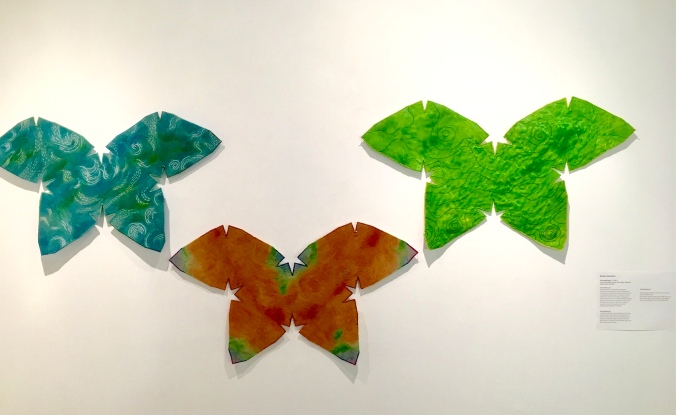Odds that President Donald Trump will win the Nobel Peace Prize this year are 20 to one, according to “VENT,” one photographer’s response to climate change. Odds that he will say aliens exist, if you ask the same photographer? Also 20 to one.
“VENT” is just one of an immeasurable amount of responses to global climate change. Many of these responses materialize through artistic means, some of which have been collected for an exhibition at Agnes Scott College. The exhibit features twelve such artists and is titled, “Weather/Otherwise,” a conglomeration of interpretations of climate and its impacts.

On a wall adjacent to “VENT,” you’ll find a series of butterflies embroidered with fabrics and linens, collectively called “Schmetterlinge.” The artist behind these creatures, Bettina Matzkuhn, sees her work as a way to emphasize the importance of using maps to track weather patterns. After all, continuing to do so may help us understand the larger implications of global climate change.
“I borrow the butterfly shape to conflate international atmospheric data, and the Earth, with the delicacy of butterfly wings,” Matzkuhn writes in a description of her contribution to the Agnes Scott installation. She’s got a point.

A theme recurs throughout this exhibit: Animals are crucial factors that shape our ability to understand and discuss climate change. Animals also take unbelievable and unnecessary hits due to climate change impacts, which you’d see just by looking at Ohotaq Mikkigak’s drawing of a yellow polar bear attempting to drink chestnut-colored waste from an overturned trash bin. Mikkigak has named the drawing, “Untitled.” Maybe because he doesn’t have the words to describe such an endemic to the public. Maybe because he’s so appalled himself.
You’d also get a grip on the climate change-related costs incurred by animals by experiencing the irony Bruce Bobick employs in his watercolor paintings. He titles one, “The Great Snowy Owl Appears in the Tropics.” And he uses an important juxtaposition: No matter how great and powerful a species is in its own environment, when it’s expelled due to reasons beyond its control, what can be done?

Bobick hits the same note with a series of three more watercolor paintings, collectively called, “The Puzzled Penguin Triptych.” He writes in a description of his paintings, “I have combined disparate elements and forms in an effort to make viewers scratch their heads and seek to make connections,” and these connections aren’t always so obvious, he notes.
The exhibit also introduces works that are subject to wider interpretations. There’s one collection of mixed-media sculptures; there’s one interactive assembly line of binoculars that lead to users’ eyes to different field environments. There’s one collection of loudly clashing colors and materials that takes up an entire room, while a TED Talk plays on the only empty wall (see video below).
All these individual projects seem to illustrate common goals, connected by the list of facts and statistics that accompanies “VENT,” compiled by the same photographer who predicts Trump will gain both a Nobel Peace Prize and a colony of loyal extraterrestrial beings.
The minimum number of animal species that haven’t been observed, without being declared extinct, for about 10 years? That would be 857 species. How about for 100 years? That would be 104 species.
The number of species anticipated to be lost to climate change impacts? That ratio is one in six. Simple enough, right? You had no idea. Neither did I. So the most useful part of this entire exhibition, for most users, at least, was one book placed delicately atop a stumpy white column. Global Climate Change: A Primer, it’s called. I hope you’ll pick it up.
All photos and videos by Emily Sullivan.